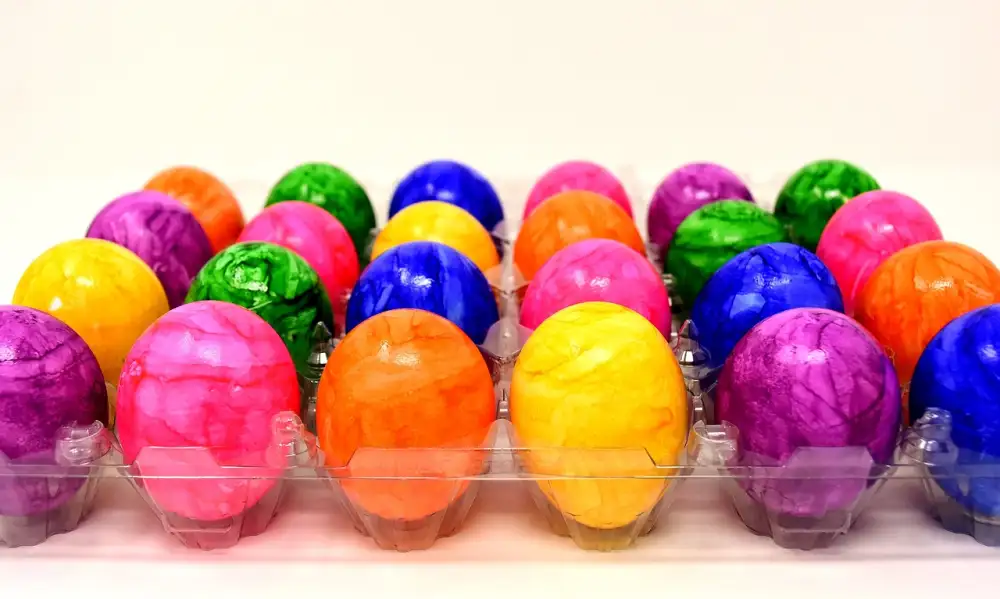Elevate Your Easter Feast with this Traditional Easter Bread Recipe

- History and Significance of Easter Bread in Different Cultures
- Ingredients Required to Make Easter Bread at Home
- Step-by-Step Instructions for Making Easter Bread Dough
- Tips and Tricks for Perfectly Shaped and Fluffy Easter Bread
- Decorating Easter Bread: Creative Ideas to Make it Festive
- Baking and Serving Easter Bread: Best Practices for Delicious Results
- Variations and Additions: Exploring Different Flavors and Fillings for Easter Bread
- Easter Bread Recipes from Renowned Chefs: Inspiration for Gourmet Creations
Easter is a time of joy and celebration, and what better way to elevate your Easter feast than with a delicious homemade Easter bread? This traditional delight has been enjoyed by families for generations, bringing a sense of warmth and tradition to the holiday table. With its rich flavor and beautiful presentation, Easter bread is sure to impress your loved ones and make your celebration truly special. In this article, we will explore the history, significance, and step-by-step instructions for making this delectable treat at home. Get ready to embark on a culinary journey that will delight your taste buds and create cherished memories with your family and friends.
History and Significance of Easter Bread in Different Cultures
Easter bread holds a special place in the hearts and traditions of many cultures around the world. Its history dates back centuries, with each culture adding its own unique touch to this delightful treat. In Greece, Easter bread known as "tsoureki" is often braided and flavored with orange zest and mahleb. In Italy, "pane di Pasqua" is shaped into intricate designs and sometimes filled with eggs or candied fruits. Eastern European countries like Poland and Ukraine have their own versions, such as "babka" and "paska," which are rich in butter and eggs. Regardless of the cultural variation, Easter bread symbolizes new beginnings, abundance, and the joy of Easter celebrations.
Ingredients Required to Make Easter Bread at Home
To make Easter bread at home, you will need the following ingredients:
- 4 cups all-purpose flour
- 1/2 cup sugar
- 1 package active dry yeast
- 1 teaspoon salt
- 1/2 cup warm milk
- 1/2 cup unsalted butter, melted
- 4 eggs
- 1 teaspoon vanilla extract
- Zest of one lemon
These ingredients are essential for creating the perfect dough that will result in a soft and flavorful Easter bread. Make sure to gather all the ingredients before starting the baking process to ensure a smooth and enjoyable experience.
Step-by-Step Instructions for Making Easter Bread Dough
1. In a large mixing bowl, combine 2 cups of flour, 1/4 cup of sugar, and 2 teaspoons of active dry yeast.
2. In a separate saucepan, heat 1 cup of milk and 1/4 cup of butter until warm (about 110°F).
3. Gradually pour the warm milk mixture into the dry ingredients, stirring well to combine.
4. Add in 3 beaten eggs and mix until a sticky dough forms.
5. Slowly add in another 2 cups of flour, one cup at a time, until the dough becomes smooth and elastic.
6. Knead the dough on a floured surface for about 5 minutes until it is no longer sticky.
7. Place the dough in a greased bowl, cover with a clean kitchen towel, and let it rise in a warm place for about an hour or until doubled in size.
8. Punch down the risen dough and divide it into three equal parts.
9. Roll each part into a long rope shape and braid them together to form a loaf.
10. Transfer the braided loaf onto a baking sheet lined with parchment paper.
11. Cover the loaf with the kitchen towel again and let it rise for another 30 minutes.
12. Preheat your oven to 350°F (175°C).
13. Brush the risen loaf with an egg wash made from one beaten egg mixed with a tablespoon of water.
14. Bake for about 25-30 minutes or until golden brown on top and cooked through.
15. Remove from the oven and let it cool before slicing and serving this delicious homemade Easter bread!
Tips and Tricks for Perfectly Shaped and Fluffy Easter Bread
To achieve perfectly shaped and fluffy Easter bread, here are some tips and tricks to keep in mind. Firstly, make sure your yeast is fresh and active by proofing it in warm water with a pinch of sugar. This will ensure a good rise. Secondly, knead the dough well until it becomes smooth and elastic. This helps develop gluten, resulting in a lighter texture. Thirdly, allow the dough to rise in a warm place, free from drafts, until it doubles in size. This may take about 1-2 hours depending on the temperature. Finally, when shaping the bread, handle it gently to avoid deflating the dough. With these tips, you'll be able to create beautifully shaped and fluffy Easter bread that will impress your guests.
Decorating Easter Bread: Creative Ideas to Make it Festive
Decorating Easter Bread is a fun and creative way to make it even more festive for your Easter celebrations. Here are some ideas to help you elevate the appearance of your homemade Easter Bread:
1. Glaze and Sprinkles: After baking, brush the top of the bread with a sweet glaze made from powdered sugar and milk. Then, sprinkle colorful sprinkles or edible glitter on top for a whimsical touch.
2. Colored Eggs: Traditionally, Easter Bread is adorned with colored eggs. Before baking, carefully place dyed eggs in the braided sections of the bread dough. As the bread bakes, the eggs will cook too, creating a beautiful effect.
3. Icing Drizzle: Once your Easter Bread has cooled, drizzle it with a simple icing made from powdered sugar and lemon juice or milk. Use a spoon or piping bag to create intricate patterns or write festive messages.
4. Fresh Flowers: Add a touch of spring by placing fresh flowers on top of your Easter Bread before serving. Make sure to use edible flowers that are safe for consumption.
5. Chocolate Ganache: For chocolate lovers, drizzle melted chocolate ganache over the bread or dip individual slices into warm ganache for an indulgent treat.
Remember, when decorating Easter Bread, let your creativity shine through and have fun experimenting with different designs and toppings. Your beautifully decorated bread will not only be delicious but also visually stunning, adding to the joyous atmosphere of your Easter feast.
Baking and Serving Easter Bread: Best Practices for Delicious Results
Baking Easter bread requires some attention to detail in order to achieve delicious results. Here are some best practices to follow:
1. Preheat the oven: Make sure your oven is preheated to the correct temperature before placing the bread inside. This ensures even baking and a golden crust.
2. Use a baking stone or tray: For a crisp bottom crust, place your Easter bread on a baking stone or tray rather than directly on the oven rack.
3. Brush with egg wash: Before baking, brush the top of the bread with an egg wash mixture to give it a glossy finish and enhance its color.
4. Rotate halfway through baking: To ensure even browning, rotate your Easter bread halfway through the baking process.
5. Cool completely before slicing: Allow the bread to cool completely on a wire rack before slicing it. This helps retain moisture and prevents it from becoming dry.
When serving Easter bread, consider cutting it into slices or tearing it into smaller pieces for sharing. Serve it as is or with butter, jam, or honey for added flavor. Enjoy this delightful treat with loved ones during your Easter celebrations!
Variations and Additions: Exploring Different Flavors and Fillings for Easter Bread
While the traditional Easter bread recipe is a delight on its own, you can also experiment with different flavors and fillings to add your own unique twist. Here are some ideas to get you started:
1. Sweet Variations: Add a touch of sweetness by incorporating ingredients like raisins, dried fruits, or chocolate chips into the dough. You can also sprinkle powdered sugar or drizzle a glaze over the finished bread for an extra dose of decadence.
2. Savory Fillings: If you prefer a savory Easter bread, consider adding ingredients like cheese, herbs, or even diced ham to the dough. These additions will give your bread a delightful savory flavor that pairs well with soups or as a side dish for your Easter feast.
3. Nutty Delights: For those who enjoy the crunch of nuts in their baked goods, try adding chopped almonds, walnuts, or pecans to the dough. Not only will this add texture to your bread but it will also infuse it with a delicious nutty flavor.
4. Fruity Twists: Experiment with different fruits such as dried cranberries, apricots, or even fresh berries to give your Easter bread a burst of fruity goodness. These fruity additions will not only enhance the taste but also make your bread visually appealing.
Remember to adjust the quantities accordingly when adding these variations so that they don't overpower the overall taste of the bread. Get creative and have fun exploring different flavors and fillings that suit your preferences!
By incorporating these variations and additions into your Easter bread recipe, you can elevate this traditional delight into something truly extraordinary that will impress your family and friends during this festive season.
Easter Bread Recipes from Renowned Chefs: Inspiration for Gourmet Creations
If you're looking to take your Easter bread to the next level, why not draw inspiration from renowned chefs? These culinary experts have put their own unique spin on this traditional delight, creating gourmet creations that are sure to impress. From flavor combinations to innovative techniques, these recipes will elevate your Easter feast and leave your guests wanting more. So, let's dive into some of these mouthwatering recipes and get ready to create a truly memorable Easter bread experience.
In conclusion, Easter bread is a delightful tradition that brings families and loved ones together during the Easter celebrations. By making this homemade treat, you can elevate your Easter feast and create restaurant-quality food at home. Whether you follow a traditional recipe or add your own creative twist, the joy of baking and sharing Easter bread with loved ones is truly special. So gather around the table, savor each bite, and create lasting memories with this delicious homemade delight. Happy Easter!
Published: 06. 01. 2024
Category: Home



